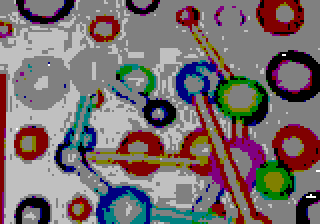
found GIF
(those with Macs haven't seen these GIFs I've been reposting as they were intended to look before, FWIW)

found GIF
(those with Macs haven't seen these GIFs I've been reposting as they were intended to look before, FWIW)
Express any opinion other than "it's all good" and you will be called Greenberg.
You could probably surf around and find bloggers arguing for a "high art" that shouldn't be mingled with low. Anyone with less writing skill than Clement Greenberg is going to make that sound pretty pompous and "out of it," at this point. Even Greenberg admitted in his later years that kitsch had gotten better in the decades after he wrote his essay "Avant Garde and Kitsch."
Artists need their straw people, though: an entire generation ascended in the art academy rebelling against Greenberg's purist ideals of non-commingled art forms. Without his strong spine the culture of rebellion falls apart into semi-articulated cults. So it becomes necessary to perennially construct mini-Greenbergs: imagined foes of low culture who can be shot down.
Thus, if you say this or that artwork or expression is bad, you are presumed to have a rule book in your head and it must be as authoritarian and ascetic as Clem's was. That you might be arguing contingently and with as much guerrilla purpose as the so-called rebels is not considered--you have overstepped.
A good academic post-modernist works by stealth. Never stating anything publicly that suggests that a work is "good" or "bad" but maneuvering behind the scenes to advance a canon based no less on personal taste than that of the loudmouthed Greenbergs-of-the-moment.
A bad academic post-modernist (which is to say a good post-modernist) attacks if necessary, sacrificing near-term status and bonhomie with colleagues by acting as a pre-emptive false Greenberg. In the belief that stating an opinion is better than lying back and sniping. A canon of a different sort will emerge: one based on considered judgments of individual expressions (high, low, or indifferent), with the apparent inconsistencies ironed out over time.

This was reblogged on Rhizome.org in '06 but Google seems to have lost it. A little digging and I found the permalink: Time Lapse Molecule 2. (Re-reblog.)
Update, January 2011: Rhizome keeps revamping its system of archiving reblog posts. The post where this appeared has changed permalinks a couple of times. It can currently be found here but the originating URL is gone so it appears to be a piece of artwork by the reblogger Marisa Olson. All posts that were originally reblog posts are now archived as "editorial" and tagged "reblog archive."
Something I wrote in a snit a few years back: "Marketing culture wrecks everything it touches" (after encountering Harry Nilsson's song "He Needs Me" in a mawkish Nike commercial)
is being construed by an Internet interlocutor as
"High popular art must never cross the line to be used in low popular art contexts" (a paraphrase but I think that's the gist).
"He Needs Me" worked ironically in Altman's Popeye when Shelley Duvall sang it about wifebeater Bluto, and it worked in PT Anderson's Punch Drunk Love when sung over shots of Adam Sandler as a more contemporary rageoholic. It did not work as an anthem for a school girl's ordinary crush on her tennis coach.
Somehow saying this has been translated into "drawing a hard line" between high and low Pop (whatever those are). That was not my meaning. Dissing commercials doesn't necessarily mean proclaiming anything as "high" or claiming that it's inviolable. By and large commercials do suck--few dispute this. It's more a question of honesty than aesthetics.